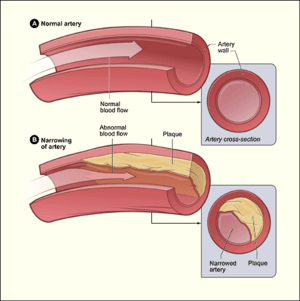Arteriosclerosis facts for kids
Arteriosclerosis is a health problem where your arteries become thick, hard, and lose their stretchiness. Think of arteries as flexible tubes that carry blood all over your body. When they get stiff, it's harder for blood to flow through them.
Contents
Types of Arteriosclerosis
There are three main kinds of arteriosclerosis:
Atherosclerosis
This is the most common type. It happens when a sticky substance called plaque builds up inside your arteries. This plaque is often made of cholesterol, fats, and calcium. As plaque grows, it narrows the arteries, making it harder for blood to pass through. This type usually affects larger and medium-sized arteries.
Mönckeberg Arteriosclerosis
In this type, the middle layer of the artery walls becomes stiff. This stiffness is caused by calcium deposits. It's like the artery walls are getting tiny bits of rock inside them, making them less flexible.
Arteriolosclerosis
This type affects the body's smaller arteries, called arterioles. When these tiny arteries harden, it can impact blood flow to different organs.
What Happens When Arteries Harden?
When arteries become stiff and narrow, your body's blood flow can slow down or even get blocked. This can lead to serious health issues.
Effects on Blood Flow
- If blood flow to the brain is low, you might feel dizzy or numb. You could also have trouble speaking clearly.
- Sometimes, a thrombosis (a blood clot) can form in a narrowed artery. This clot can completely block blood flow.
Serious Health Risks
Blocked blood flow can put you at risk for:
- A stroke, which happens when blood flow to part of the brain is stopped.
- A heart attack, which occurs when blood flow to a part of the heart is blocked.
Preventing Arteriosclerosis
Arteriosclerosis is a major health concern, but you can often prevent it by making healthy choices.
Healthy Lifestyle Choices
Doctors recommend a few key things to reduce your risk:
- Eat a healthy diet: Try to eat foods that are low in cholesterol and unhealthy fats.
- Exercise regularly: Being active helps keep your heart and arteries strong.
- Avoid smoking: Smoking is very harmful to your arteries and greatly increases your risk.
- Maintain a healthy weight: Being overweight can also increase your risk.
Sometimes, doctors might prescribe medicines to help lower the amount of cholesterol in a person's blood.
Images for kids
See also
 In Spanish: Arteriosclerosis para niños
In Spanish: Arteriosclerosis para niños




